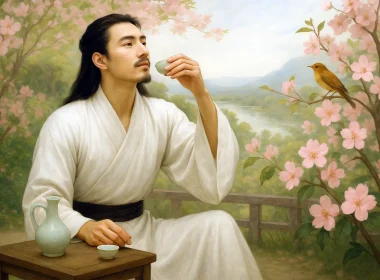Under blue mountains we wound our way,
My boat and 1, along green water;
Until the banks at low tide widened,
With no wind stirring my lone sail.
...Night now yields to a sea of sun,
And the old year melts in freshets.
At last I can send my messengers --
Wildgeese, homing to Loyang.
Original Poem
「次北固山下」
王湾
客路青山外,行舟绿水前。
潮平两岸阔,风正一帆悬。
海日生残夜,江春入旧年。
乡书何处达?归雁洛阳边。
Interpretation
Composed in the early 8th century during Wang Wan's journey from Chang'an to the Wu region, this poem captures the poet's reflections while passing Mount Beigu (north of modern Zhenjiang, Jiangsu). Situated at the confluence of the Yangtze River and the Grand Canal, this strategic location inspired the poet's meditation on travel and homesickness amidst the vast river landscape of early spring.
First Couplet: "客路青山外,行舟绿水前。"
Kè lù qīng shān wài, xíng zhōu lǜ shuǐ qián.
The traveler's road winds beyond green hills, My boat advances where blue water spills.
These opening lines establish the journey's spatial coordinates. The "green hills" (Mount Beigu) and "blue water" (Yangtze River) frame both the physical passage and the emotional undercurrent of the traveler's solitude.
Second Couplet: "潮平两岸阔,风正一帆悬。"
Cháo píng liǎng àn kuò, fēng zhèng yī fān xuán.
High tide levels both river shores so wide, A fair wind hoists my single sail with pride.
The dynamic equilibrium of nature emerges here - the tide's horizontality ("levels both shores") contrasting with the sail's verticality. This perfect alignment of natural forces suggests both smooth sailing and the traveler's vulnerability to these vast forces.
Third Couplet: "海日生残夜,江春入旧年。"
Hǎi rì shēng cán yè, jiāng chūn rù jiù nián.
The sea-born sun devours night's last trace, While river spring steals through old year's space.
This philosophically rich couplet pivots between temporal dimensions. The cosmic spectacle of dawn over water merges with the subtle arrival of spring before the lunar new year, embodying nature's constant renewal against human calendars.
Fourth Couplet: "乡书何处达?归雁洛阳边。"
Xiāng shū hé chù dá? Guī yàn Luòyáng biān.
Where might homebound letters find their way? With northbound geese to Luoyang they'll convey.
The conclusion transforms observation into longing. The migratory geese (traditional letter-carriers in Chinese lore) bridge the physical distance between the Yangtze and the poet's northern home, embodying both the possibility and melancholy of connection across separation.
Holistic Appreciation
The poem unfolds through the poet's observations and reflections during his journey, progressing layer by layer. It begins with the scenery of mountains and rivers, depicting a tranquil scene of calm tides and steady sails, then shifts from the morning landscape to the transition of seasons, ultimately culminating in a surge of homesickness. With lucid and vivid language, the poet seamlessly blends the landscapes of his southern travels with the emotions of longing, immersing the reader in both the serene beauty of the journey and the profound melancholy of nostalgia.
The line "海日生残夜,江春入旧年。" has been celebrated by later generations as a "strikingly profound couplet." Its fresh perspective and layered imagery elevate the entire poem. The work is meticulously balanced in structure, blending scene and emotion, offering both visual beauty and emotional depth.
Artistic Merits
The poem is tightly structured, progressing naturally from description to lyrical expression. Its language is crisp and fluid, with precise parallelism and carefully chosen diction—particularly the renowned couplet mentioned above, which stands out for its innovative imagery and seamless fusion of scene and sentiment. The poet excels at using natural landscapes to mirror inner emotions, transforming the sights of travel into expressions of homesickness. The emotion is profound yet restrained, the meaning far-reaching yet subtly conveyed.
Insights
This poem uses scenery to evoke emotion and emotion to enrich the scenery, revealing the deep attachment to homeland in the classical tradition of "traveler’s thoughts." It reminds us that no matter where we are, our feelings for home never fade with time. In modern society, this yearning for belonging remains deeply rooted in the human heart. The poet’s approach—expressing inner sentiment through brisk rhythm and crystalline imagery—also inspires us to convey emotions through concise yet evocative visuals, creating resonant and moving lyrical works.
Poem translator
Kiang Kanghu
About the Poet
Wang Wan(王湾), a Tang Dynasty poet from Luoyang, Henan, left only ten surviving poems. Yet his masterpiece "A Mooring Under North Fort Hill" secured his immortal fame in literary history. This grand and philosophical work not only embodies the majestic spirit of the High Tang period but also foreshadows the poetic transition from Early Tang to High Tang styles.












